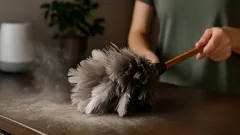
Everyone enjoys coming home to a tidy space, but lately, have you noticed your home turning into a dusty swarm? No matter how often you sweep and mop, the layers keep coming back. Many homeowners wonder why dust always piles up. On top of that, a dusty environment can cause allergies and affect your health. In the next few minutes, you'll learn the secrets behind dust in your home and easy steps to make your space healthier, cleaner, and more inviting.
Forgotten Spots Are Dust Traps
Have you ever wondered where all the dust comes from? Believe it or not, up to 80 percent of dust in our homes usually stays in places we almost never clean — behind furniture, under beds, or on top of high shelves. These places gather everything from dead skin cells to tiny fabric fibers. Make it a habit to clean these areas at least once every month. If you're like me, seeing those freshly cleaned spaces after a deep clean is really satisfying!

Poor Air Circulation Makes Things Worse
If your home has poor air circulation, dust lingers in the air longer and settles everywhere. Stale air lets microscopic particles build up, sometimes making indoor air less pleasant than outside. Clean or change your air filters in AC or heater units at least every three months for the best effect. Even opening a window for just an hour a day can greatly cut down dust levels.
Textiles Are Secret Dust Factories
Your cozy curtains, carpets, and bedding are big dust magnets. An average carpet can hold up to 1 kilogram of dust! Wash your bedding every week in hot water. Curtains and rugs? Make sure to wash or vacuum these at least every couple of weeks. If you’re dealing with allergies, you might want to go for tile or hardwood floors and blinds instead of thick drapes.
Dust that isn't managed well can build up quickly and even be visible in just a few hours if the conditions are right.
Humidity Shapes Dust's Behavior
Humidity also affects dust. If it's too dry, dust stays afloat longer — if it's too humid, the dust sticks tightly onto surfaces. Try to keep the humidity inside your home between 40–60 percent. A simple humidifier or dehumidifier can help reduce dust and make breathing easier. This balance isn’t just good for dust — it helps your health and skin, too.
Home Habits Inviting More Dust
Sometimes, it’s our daily habits that bring in more dust. Often, opening windows without screens, wearing shoes inside, and not grooming our pets regularly all add to the problem. Here’s a quick checklist you can follow:
- Wash curtains and bedding regularly
- Place doormats on both sides of entrances
- Groom pets regularly
- Use a vacuum cleaner with a HEPA filter
- Store fabrics and clothes in sealed containers
Keeping your home dust-free isn't about achieving perfection, but knowing which spots need your focus. Tackle those hidden dust traps, check your air quality, and remember that your fabrics need regular attention. Watch your habits, and you’ll notice a real difference. So the next time you wonder, why is my house so dusty? — remember these tips and you’ll enjoy a fresher, brighter home every day.
 Meg Magazine
Meg Magazine















Comments